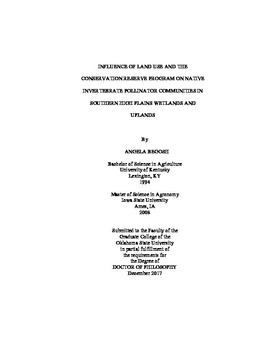| dc.contributor.advisor | Smith, Loren M. | |
| dc.contributor.author | Begosh, Angela | |
| dc.date.accessioned | 2019-03-22T18:57:14Z | |
| dc.date.available | 2019-03-22T18:57:14Z | |
| dc.date.issued | 2017-12 | |
| dc.identifier.uri | https://hdl.handle.net/11244/317672 | |
| dc.description.abstract | Numerous studies have documented that invertebrate pollinator services are critical to the world economy. The Southern High Plains (SHP) of Texas was identified as an area where the demand for pollination service may exceed availability in the future. Therefore, in 2013 and 2014, we collected pollinators and anthophiles using blue vane traps and sweep nets in cropland, conservation land, and native grasslands of this region because there is a lack of data on pollinator occurrence. Our objective was to determine how the predominant land uses affect invertebrate pollinator abundance, species richness, and diversity, and more specifically, if the Conservation Reserve Program (CRP) can provide quality habitat for pollinators in the High Plains. We also examined how playa wetlands embedded within these land uses contribute to pollinator habitat. Playas are refugia of diversity in an arid landscape and threatened with loss from sedimentation and land conversion. Blue vane trap and sweep netting showed that CRP had consistently lower total abundance, overall species richness, and diversity than native grassland and cropland, which were similar. With blue vane traps, when land type was a significant effect, uplands had higher abundance, richness, and diversity than playas. However, sweep net data showed that pollinators frequently foraged on wetland plants. We then evaluated vegetation characteristics of the three primary SHP land uses and their embedded playas. AIC model selection and path analysis showed that percent grass and duff cover of the land uses were the primary factors influencing pollinator abundance and richness. CRP had the most adverse effect on total pollinator abundance and richness, likely because of the high percentage of dense, non-native grasses and low floral cover. CRP could be improved by creating seed mixes that include native grasses and native flowering forbs to replace existing non-native grasses to enhance the availability of nesting sites for solitary bees and expand floral resources. Native grasses in CRP uplands will also allow for a more natural hydrology of the CRP playas and encourage growth of wetland plants. Implementing buffers strips around playas seeded with native grasses and flowering forbs could serve as valuable refugia for pollinators and protect cropland playas from sedimentation. | |
| dc.format | application/pdf | |
| dc.language | en_US | |
| dc.rights | Copyright is held by the author who has granted the Oklahoma State University Library the non-exclusive right to share this material in its institutional repository. Contact Digital Library Services at lib-dls@okstate.edu or 405-744-9161 for the permission policy on the use, reproduction or distribution of this material. | |
| dc.title | Influence of land use and the Conservation Reserve Program on native invertebrate pollinator communities in Southern High Plains wetlands and uplands | |
| dc.contributor.committeeMember | McMurry, Scott T. | |
| dc.contributor.committeeMember | Davis, Craig A. | |
| dc.contributor.committeeMember | Giles, Kristopher L. | |
| osu.filename | Begosh_okstate_0664D_15584.pdf | |
| osu.accesstype | Open Access | |
| dc.type.genre | Dissertation | |
| dc.type.material | Text | |
| thesis.degree.discipline | Zoology | |
| thesis.degree.grantor | Oklahoma State University | |
